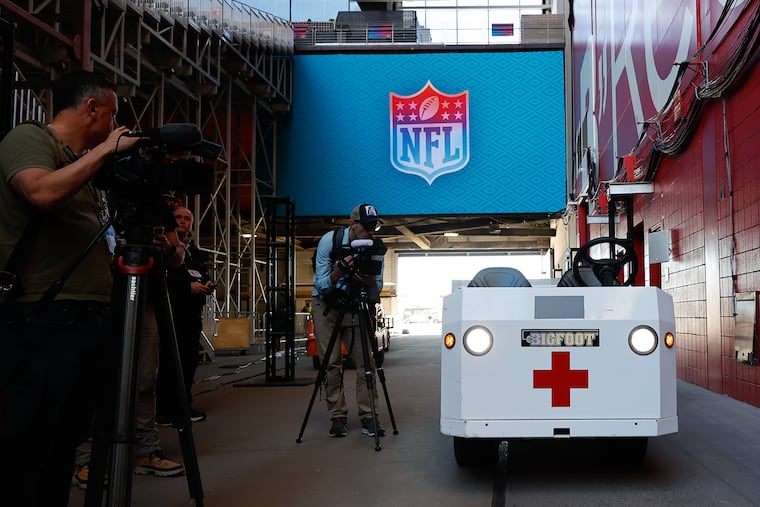From live births to life-threatening injuries: the NFL says it can handle all that (and more) at Super Bowl LVII
There's a total of 30 medical staffers between both teams and the NFL looking our for the health and safety of players during the game.

GLENDALE, A.Z.- If Jason Kelce’s wife, Kylie, goes into labor early at Super Bowl LVII on Sunday, the small army of medical personnel on hand at State Farm Stadium could handle it.
“I have delivered 54 in my car. Not any recently. But this is not the first one,” said Dr. Jim Ellis, an emergency preparedness consultant with the NFL. “We would have everything we need to support them if that were to happen.”
The wife of an unnamed Green Bay Packer gave birth, Ellis said, on the morning of Super Bowl XLV in Dallas in 2011.
Ellis and a team of NFL doctors and trainers were in State Farm Stadium Thursday afternoon to discuss team health and safety, everything from live births to concussions, days ahead of the Super Bowl. Officials added that every NFL game is paid this much attention, when it comes to health and safety protocols.
“Everything you’re going to see today is not here just because it’s the Super Bowl,” said Dr. Allen Sills, the NFL’s chief medical officer. “We have to plan against the common scenarios that we might see. We all hope and pray we’ll never see any of those, but as [we] saw earlier this year, sometimes that’s needed and when it’s needed, we want to be prepared.” Sills referred to the time inDecember when Buffalo Bills safety Damar Hamlin went into cardiac arrest and was revived on the field.
“Our emergency plan was handled to a T a few weeks ago with the Damar Hamlin situation,” Ellis said. “There was a good outcome because we followed the plan. We also practiced the plan extensively in the preseason. We practice a cardiac arrest scenario. We practice doing CPR and using the defibrillator.”
The Super Bowl’s medical team will number about 30, including staff from both teams, the NFL, and the stadium. That includes a dentist, an ophthalmologist, and a chiropractor. There will be two ambulances parked, just beyond the end zone, ready to take injured players to the nearest trauma center if needed.
Sills took visitors into the blue tent on the sidelines, to discuss sideline concussion evaluations. Only a handful of staff are allowed inside, including a team doctor, an unaffiliated neurotrauma consultant, who wears a red hat, and an athletic trainer. All three play a part in the evaluation.
“One of the subtle signs of a concussion sometimes is a personality change,” Sills said. “That is information only a team doctor might have, someone who’s seen that player every day.”
Sills said there were 427 concussion evaluations this season and the team doctor and independent consultant disagreed on the diagnosis just once. Players, he said, are so used to concussion evaluations today that few of them fight the “no-go” diagnosis. The player’s helmet is taken away, just in case.
“We do 3 to 4 negative evaluations for every one we diagnose,” Sills said. “The players are confident we’re going to get it right.”
The NFL doesn’t always get it right. In September, Miami Dolphins quarterback Tua Tagovailoa’s head injury was diagnosed as a back injury and he was allowed to play. A week later, he suffered a gruesome concussion against the Cincinnati Bengals.
The NFL added more criteria to the concussion checklist as a result of Tagovailoa’s misdiagnosis.
“We made the protocol more conservative as a result of that,” Sills said.
Far above the tent, in a small room by the press box, medical spotters sit in front of an array of screens showing multiple angles of the game. Their job, Sills said, is to spot any signs of head injuries among the players that coaches, referees, or teammates may have missed. If they do see a player exhibiting signs of a concussion, a button on a small, black box can stop the game for a medical timeout.
“The spotters are empowered to push the button if they see a head or neck injury,” Sills said. “They don’t watch the game like a fan. They don’t care about score, time or distance. They’re looking for injuries.”